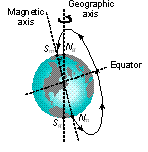Earth’s Magnetic Field
As per the most established theory it is due to the rotation of the earth where by the various charged ions present in the molten state in the core of the earth rotate and constitute a current.
(1) The magnetic field of earth is similar to one which would be obtained if a huge magnet is assumed to be buried deep inside the earth at it's centre.
(2) The axis of rotation of earth is called geographic axis and the points where it cuts the surface of earth are called geographical poles (Ng, Sg). The circle on the earth's surface perpendicular to the geographic axis is called equator.
(3) A vertical plane passing through the geographical axis is called geographical meridian.
(4) The axis of the huge magnet assumed to be lying inside the earth is called magnetic axis of the earth. The points where the magnetic axis cuts the surface of earth are called magnetic poles. The circle on the earth's surface perpendicular to the magnetic axis is called magnetic equator.
(5) Magnetic axis and Geographic axis don't coincide but they makes an angle of 17.5° with each other.
(6) Magnetic equator divides the earth into two hemispheres. The hemisphere containing south polarity of earth's magnetism is called northern hemisphere while the other, the southern hemisphere.
(7) The magnetic field of earth is not constant and changes irregularly from place to place on the surface of the earth and even at a given place in varies with time too.
(8) Direction of earth's magnetic field is from S (geographical south) to N (Geographical north).

Elements of Earth's Magnetic Field
The magnitude and direction of the magnetic field of the earth at a place are completely given by certain. quantities known as magnetic elements.
(1) Magnetic Declination : It is the angle between geographic and the magnetic meridian planes.

Declination at a place is expressed at or depending upon whether the north pole of the compass needle lies to the east or to the west of the geographical axis.
(2) Angle of inclination or Dip (ø): It is the angle between the direction of intensity of total magnetic field of earth and a horizontal line in the magnetic meridian.
(3) Horizontal component of earth's magnetic field (BH) : Earth's magnetic field is horizontal only at the magnetic equator. At any other place, the total intensity can be resolved into horizontal component (BH) and vertical component (BV).

